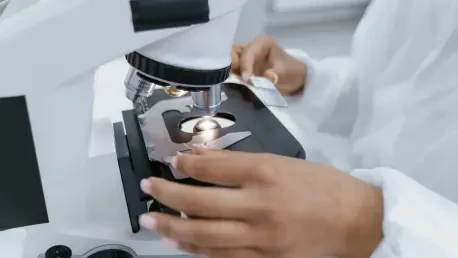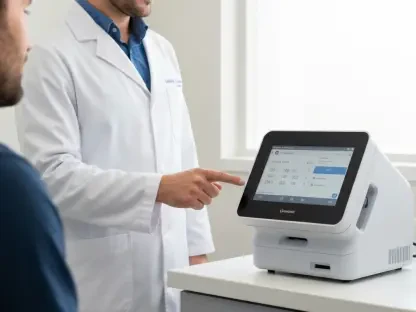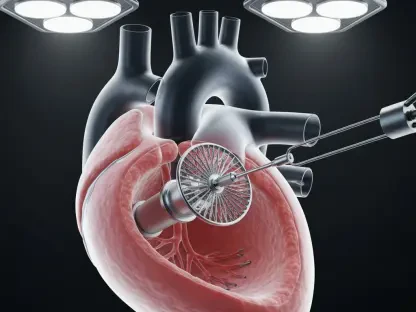The medical community continuously seeks ways to improve patient care and outcomes, and platelet analysis is becoming a focal point of innovation. Platelets, critical components in the human circulatory system, are involved in the formation of blood clots, a process crucial for preventing excessive bleeding following an injury. While the role of these tiny, two-micrometer entities is indisputable, accurately assessing their functionality has long posed challenges to clinicians. Traditional methods often require substantial blood samples and fail to provide sufficiently detailed insights into platelet behavior. These inadequacies make it difficult to address platelet dysfunction effectively, particularly in emergency medical situations like surgical procedures or trauma management. Recently, cutting-edge technologies have emerged to tackle these issues head-on, focusing on the ability to precisely measure the force exerted by platelets. This advancement promises more individualized and accurate diagnostics, changing the landscape of medical technology and patient care.
Platelet Function and Its Critical Role
Platelets have a unique role in the circulatory system, acting alongside proteins to form clots that prevent uncontrolled bleeding. Although these entities were first characterized by Giulio Bizzozero in 1882, the complexity of their functionality wasn’t fully understood until the late 20th century. When an injury occurs, platelets are rapidly drawn to damaged blood vessel walls where they adhere and activate through chemical signals. This activation induces drastic transformations: they alter their shape, activate the release of clotting agents, and begin to aggregate. This coordinated sequence is vital; any disruption leads directly to impaired clotting ability, forming the basis for numerous platelet-related medical conditions. Pharmaceutical interventions aim to modulate platelet activity, particularly during procedures like heart surgeries, where anticoagulation drugs are utilized before being reversed when normal clotting is needed. Any capability that offers precise measurements of platelet activity is invaluable, aiding physicians in making accurate medical assessments during critical procedures.
Conventional Methods: Limitations and Challenges
Traditional methods of platelet functionality assessment, though widely used, offer only a partial view of this fatally important biological process. Tests focusing on platelet concentration and aggregation are common; however, they often fail to paint a comprehensive picture of platelet capability. Aggregometry evaluates how platelets clump together, while thromboelastography assesses clot characteristics, both providing some measure of platelet behavior. Nonetheless, the medical community has found these methods insufficient. High platelet counts do not guarantee effective clotting, underscoring the need for alternative measures. Physicians, particularly trauma surgeons, have voiced concerns about these tests’ limitations. Rachael Callcut highlights the disconnect between these benchmarks and actual platelet activity, advocating for new technologies to address this gap. The belief emerging among researchers is that forces exerted during platelet aggregation may hold the key to understanding dysfunction, necessitating technologies capable of measuring these microscopic forces directly within clinical settings.
Technological Innovations in Platelet Assessment
Recent innovations have enabled precise measurement of minute forces produced by platelets, potentially revolutionizing medical diagnostics. Nathan Sniadecki, a researcher and entrepreneur, began exploring cellular forces, leading to the development of a flexible cantilever structure capable of detecting the minuscule forces involved in platelet activity. This development, initially spurred by military interest in soldier trauma care, uses obstacles to encourage aggregation while simultaneously measuring force. The accuracy of this method was validated in 2019 and shows promise for assessing drug effects and predicting transfusion needs. Stasys Medical Corporation was established to commercialize this assay, creating user-friendly tools designed for practical clinical application with minimal blood samples. Such advancements highlight the push toward incorporating engineering principles into biological assessments, offering clarity on individual platelet function. These solutions address the need for accuracy in diagnosing platelet dysfunction and determining precise medical interventions.
Emerging Approaches and Broader Implications
In parallel with Sniadecki’s work, Khalid Salaita’s approach focuses on the internal forces within platelets by measuring the cytoskeletal tension. Collaborating with Roman Sniecinski, they developed the Mechano-Cas12a Assisted Tension Sensor (MCATS) to quantify these forces using engineered DNA and Cas12a proteins, creating observable signals when internal tension is measured. Published in 2023, these findings offer predictive insights into platelet transfusion needs and expand diagnostic capabilities for infants unable to provide significant blood samples. Such personalized insights are invaluable, providing physicians with decisive data to navigate complex trauma scenarios. The development of these technologies reflects a broader shift in clinical diagnostics towards nuanced and individualized patient care. As traditional reliance on platelet counts often misleads, instruments like MCATS promise to transform diagnostics by offering deeper understanding of molecular dynamics beyond simple aggregation measures.
The Future of Platelet Analysis
The journey does not end with present advancements; researchers continue seeking improvements and regulatory approval for widespread clinical use. Sniadecki and Salaita’s creations exemplify the potential of interdisciplinary methodologies to heighten accuracy in medical care, with mechanical engineering and molecular chemistry contributing new paradigms within the field. With increasing demand for precise diagnostics, these innovations provide a robust foundation for future exploration and application, paving the way for better medical outcomes. The progress made by understanding platelet forces conveys a message of intent to overcome long-standing medical challenges, offering more precision and personalization in treatment plans. Physicians anticipate harnessing these promising technologies to refine diagnostic criteria and elevate patient care practices. Looking forward, there is hope that innovations in platelet analysis will usher in an era of tailored treatments, addressing individual needs and clinical complexities more effectively than ever before.









